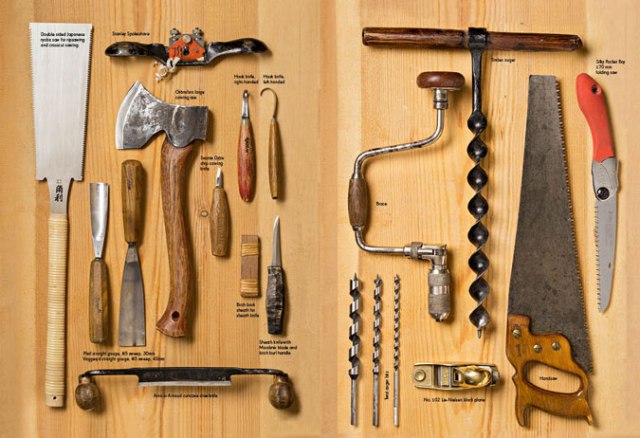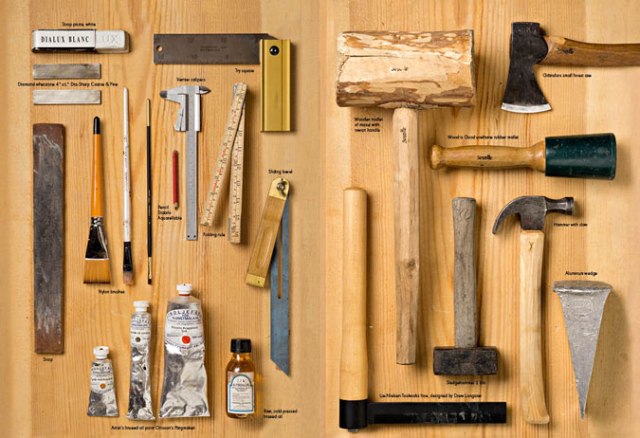 Jögge Sundqvist’s “Slöjd in Wood” is in the final editing/design stages, and will be off to Suzanne Ellison in the next day or two for the index, and to Kara Uhl for a copy edit. In other words, it’s just a couple weeks away from going to the printer. (Look for another post when it does.)
Jögge Sundqvist’s “Slöjd in Wood” is in the final editing/design stages, and will be off to Suzanne Ellison in the next day or two for the index, and to Kara Uhl for a copy edit. In other words, it’s just a couple weeks away from going to the printer. (Look for another post when it does.)
As I was editing the translation, I was charmed by almost every project – but what I find most intriguing about slöjd is its bedrock foundation in self-sufficiency and using the materials at hand.
But Jögge says it much better than can I, so I’ve shared part of his introduction below. The images at the top and bottom here are the end papers of the sumptuously photographed and illustrated book, and show the tools and supplies he uses throughout.
— Megan Fitzpatrick
There are many different ways of working and joining wood. In this book I will tell you how to work wood using hand tools. I’m dedicated to slöjd because of the tool marks and carved bevels, the worn colors, the idiosyncratic design and the self-confidence of the unschooled folk art expression.
Slöjd is part of the self-sufficient household, how people survived before industrialization. Slöjd is the work method farmers used when they made tools for house building, farming and fishing, and objects for their household needs. For thousands of years, the knowledge of the material has deepened, and the use of the tools has evolved along with the understanding of how function, composition and form combine to make objects strong and useful.
The word slöjd derives from the word stem slog, which dates to the 9th century. Slög means ingenious, clever and artful. It reflects the farmers’ struggle for survival and how it made them skilled in using the natural materials surrounding the farm: wood, flax, hide, fur, horn and metal. I have picked up a dialect expression from my home county, Västerbotten, that has become a personal motto. We say Int’ oslög, “not uncrafty,” about a person who is handy and practical.
In slöjd, choice of material and work methods are deeply connected to quality and expression. To get strong, durable objects, the material must be carefully chosen so the fiber direction follows the form. This traditional knowledge makes it easy to split and work the wood with edge tools. Slöjd also gives you the satisfaction of making functional objects with simple tools. When a wooden spoon you made yourself feels smooth in your mouth, you have completed the circle of being both producer and consumer.
My intention with this book is to give an inspiring and instructive introduction to working with wood the slöjd way: using a simple set of tools without electricity. There are many advantages to this. You can make the most wonderful slöjd in the kitchen, on the train or in your summer cottage. Simple hand tools make you flexible, free and versatile. And the financial investment compared to power tools is very low!
Traditional slöjd knowledge is vast, and requires many years of experience before you can easily make your ideas come to life. It also takes time to master the knife grips, essentials of sharpening and specific working knowledge of individual wood species.
As you work with slöjd, the learning enters your body. Through repetition, you will gain muscle memory for different tool grips. The ergonomic relationship between your body and the power needed for efficient use emerges over time. “Making is thinking,” said Richard Sennet, professor of sociology. In slöjd, the process never ends.
Because slöjd is inherently sustainable, it feels genuine and authentic. In an increasingly complex and global society, it is important for an individual to experience an integrated work process from raw material to finished product.
People from all walks of life benefit from the interaction between mind and hand. Slöjd affects us by satisfying the body and in turn, the soul. There is a kind of practical contemplation where there is time for thought – a certain focused calm, which is an antidote to today’s media-centered society.
I think we can use the knowledge of slöjd to find that brilliant combination of a small-scale approach to a sustainable society that doesn’t exclude the necessities of modern technology. Traditional slöjd is a survival kit for the future.
— Jögge Sundqvist, August 2017
